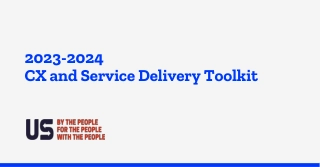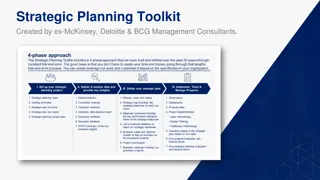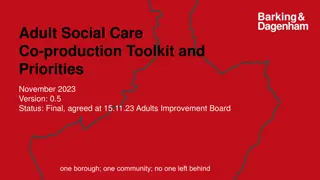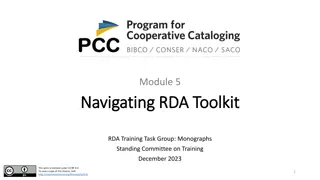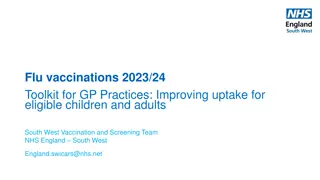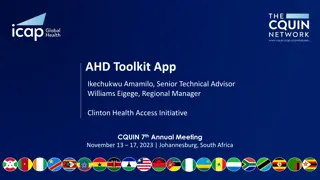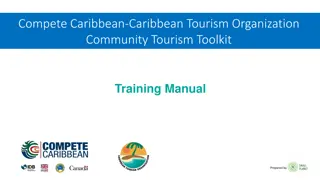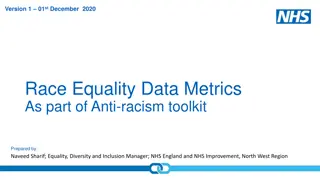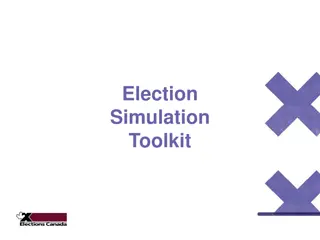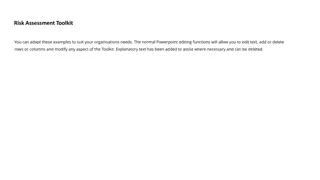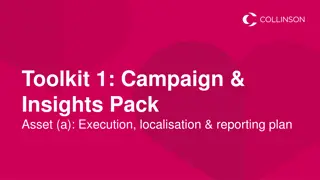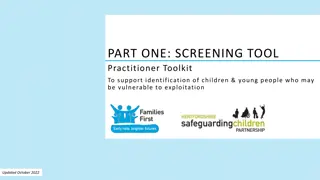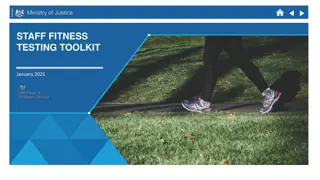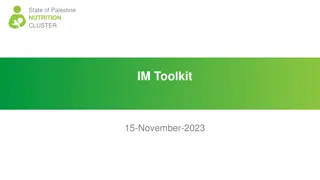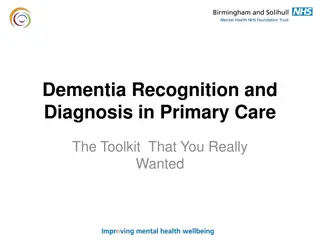
Student Leadership Placement Toolkit: Resources for Practice-Based Learning
Explore the Student Leadership Placement Toolkit designed to support students in preparing for practice-based learning. Gain insights on the benefits of leadership placements, objectives for students, and the importance of emotional intelligence in leadership development. Discover resources to empower students to think differently, network with professionals, and enhance their leadership skills through exposure to senior leaders and professional meetings.
Download Presentation

Please find below an Image/Link to download the presentation.
The content on the website is provided AS IS for your information and personal use only. It may not be sold, licensed, or shared on other websites without obtaining consent from the author. If you encounter any issues during the download, it is possible that the publisher has removed the file from their server.
You are allowed to download the files provided on this website for personal or commercial use, subject to the condition that they are used lawfully. All files are the property of their respective owners.
The content on the website is provided AS IS for your information and personal use only. It may not be sold, licensed, or shared on other websites without obtaining consent from the author.
E N D
Presentation Transcript
STUDENT LEADERSHIP PLACEMENT TOOLKIT: CONTENTS 1:Introduction 1:Introduction 2:What is a student leadership 2:What is a student leadership placement placement 3:Objectives for students 3:Objectives for students 4:Benefits of a leadership placement 4:Benefits of a leadership placement 5:To do guide: Prepare for your 5:To do guide: Prepare for your placement placement 6:Personality testing 6:Personality testing 7:Leadership Models 7:Leadership Models 8: Why is Emotional intelligence 8: Why is Emotional intelligence important in leadership? important in leadership? 9:Myth busters 9:Myth busters 10: Understanding Quality improvement 10: Understanding Quality improvement 11:Quality improvement 11:Quality improvement 12:System wide change 12:System wide change 13:What are AHP s and what do they do 13:What are AHP s and what do they do for the NHS? for the NHS? 15:To do guide during placement 15:To do guide during placement 16:Bitesize learning 16:Bitesize learning 17:Reflections from students 17:Reflections from students 18:Testimonies from professionals 18:Testimonies from professionals 19:Recognition and thanks 19:Recognition and thanks 20:References 20:References
INTRODUCTION TO THE TOOLKIT Welcome to the Student leadership tool kit. This Toolkit aims to support and offer you resources to prepare you for your Practice based learning.
WHAT IS A PRACTICE BASED LEARNING PLACEMENT? The approach is The approach is a multi profession approach a multi profession approach It It is about how students can be motivated to be leaders from the start of their higher is about how students can be motivated to be leaders from the start of their higher education experience education experience Exposure to senior leaders with years of experience in leadership Exposure to senior leaders with years of experience in leadership Better understanding of the importance of emotional intelligence Better understanding of the importance of emotional intelligence Empowering students to think differently Empowering students to think differently Networking with like Networking with like- -minded individuals minded individuals Learning from senior leaders and building students leadership objectives Learning from senior leaders and building students leadership objectives Exposing students to professional meetings Exposing students to professional meetings Understanding the Understanding the strategy strategy
OBJECTIVES FOR STUDENTS Here are some example of Here are some example of practice based learning objectives practice based learning objectives: : Understand the importance of leadership behaviours in practice, explore and reflect Understand the importance of leadership behaviours in practice, explore and reflect on these, and plan for next steps in personal development on these, and plan for next steps in personal development Gain experience of a range of senior leadership and management activities Gain experience of a range of senior leadership and management activities Lead on a focused regional workforce improvement project that increases existing Lead on a focused regional workforce improvement project that increases existing knowledge, skills and learning objectives knowledge, skills and learning objectives Increase awareness of Increase awareness of health and social care impact on day impact on day- -to to- -day NHS service provision day NHS service provision health and social care policy and strategy in England and policy and strategy in England and Improve awareness of own profession and partnership working in relation to working Improve awareness of own profession and partnership working in relation to working in a multi professional workforce in a multi professional workforce
TO DO GUIDE: PREPARE FOR YOUR PRACTICE BASED LEARNING 1. 1. Personality testing to find out how you learn best Personality testing to find out how you learn best 2. 2. Produce a mind map: What is your idea of leadership? Produce a mind map: What is your idea of leadership? 3. 3. Explore leadership styles, which one are you Explore leadership styles, which one are you? ? 4. 4. Map your skills and behaviours against a leadership framework. Map your skills and behaviours against a leadership framework. 5. 5. Organisational skills Organisational skills 6. 6. Ensure technology works Ensure technology works 7. 7. Planning project ideas Planning project ideas 8. 8. Buddy networks: Set up a buddy system or forums to find students that have already / or Buddy networks: Set up a buddy system or forums to find students that have already / or are undertaking a leadership placement are undertaking a leadership placement 9. 9. Explore roles within the organisation you are going to, key people for potential networking Explore roles within the organisation you are going to, key people for potential networking 10. 10. Set up a productive environment to work from. Set up a productive environment to work from. 11. 11. Ensure you make time for yourself for your wellbeing Ensure you make time for yourself for your wellbeing
BENEFITS OF A LEADERSHIP PLACEMENT Increasing communication skills Increasing communication skills Where the profession is heading in the future Where the profession is heading in the future Emotional intelligence Emotional intelligence Drawing ideas and knowledge from senior practitioners Drawing ideas and knowledge from senior practitioners Confidence Confidence Having voice heard as a student Having voice heard as a student Developing the leadership pillar of the 4 pillars of advanced practice. Developing the leadership pillar of the 4 pillars of advanced practice.
PERSONALITY TESTING How do you like to learn and what are your leadership preferences? To determine your leadership characteristics go to: https://www.leadershipacademy.nhs.uk/resources/healthcare-leadership- model/supporting-tools-resources/healthcare-leadership-model-self-assessment- tool/ http://www.nursingleadership.org.uk/test1.php Reflect on the findings and how this will impact yourself and others whilst on Reflect on the findings and how this will impact yourself and others whilst on placements. placements. For further reading explore MBTI developed by Isabel Myers For further reading explore MBTI developed by Isabel Myers and Katharine Briggs. and Katharine Briggs.
LEADERSHIP MODEL The way that we manage ourselves is a key part of being an effective leader. Being aware of your strengths and limitations will have a direct effect on how you behave and interact with others, and they with you. The Healthcare Leadership Model identifies nine dimensions of key leadership: Inspiring shared purpose Leading with care Evaluating information Connecting our service Sharing the vision Engaging the team Holding to account Developing capability Influencing for results 1: Healthcare Leadership Model: The nine dimensions of leadership behaviour: 2013 https://www.leadershipacademy.nhs.uk/wp- content/uploads/2014/10/NHSLeadership-LeadershipModel-colour.pdf
WHY IS EMOTIONAL INTELLIGENCE IMPORTANT IN LEADERSHIP? Emotional intelligence (sometimes referred to as EQ or EI) is the ability to comprehend, control, and develop your own feelings, while also being able to understand and manage others feelings. Leaders with high emotional intelligence create more connected and motivated teams. The skills people with emotional intelligence possess make them effective managers. People with a high degree of emotional intelligence know what they're feeling, what their emotions mean, and how these emotions can affect other people. 2: Emotional Intelligence in Leadership: Learning How to Be More Aware, 2021)
MYTH BUSTERS Myth 4: Only the boss can lead In reality, almost everyone takes on a leadership role from time to time, stepping up and stepping back as circumstances change Myth 5: Management equals leadership Managers set and enforce rules and control a group in order to accomplish defined goals. Leaders inspire, influence and encourage those around them Myth 6: Leaders must eliminate mistakes Everyone makes mistakes, but those errors help us learn and grow Myth 1: Leaders must be extroverts Reflectors and good listeners makes for sound decision making Myth 2: Leaders need to know everything Today s leaders need to be willing and able to tap into the skills and expertise of the smart people around them Myth 3: One leadership style fits all, forever Just as technical skills need to be constantly updated to remain relevant, so do motivation strategies and management styles 3: Insperity. 2021. 7 leadership myths debunked - Insperity. [online] Available at: <https://www.insperity.com/blog/leadership-myths/> [Accessed 15 March 2021]
UNDERSTANDING QUALITY IMPROVEMENT During your practice based learning you may undertake projects and Quality and service improvement work. Improving quality is about making healthcare safe, effective, patient-centred, timely, efficient and equitable. Networking to present finished project to relevant professionals Communication and discuss ideas and processes with educator Craft a project schedule Gnatt chart List goals and outline project Collaborate with stakeholders and ask for feedback List Tasks, Subtasks and milestones Here is a useful link for tools you can use to help with your project: Here is a useful link for tools you can use to help with your project: https://www.england.nhs.uk/quality-service-improvement-and-redesign-qsir- tools/
QUALITY IMPROVEMENT Plan, Do, Study, Act (PDSA) The model for improvement provides a framework for developing, testing and implementing changes leading to improvement When planning any improvement or change to work processes, it is essential to know what you want to achieve, how you will measure improvement and to be explicit about the idea to be tested 4: https://improvement.nhs.uk/documents/2142/plan- do-study-act.pdf
SYSTEM WIDE WORKING During your Leadership placement you maybe working across many professions and During your Leadership placement you maybe working across many professions and organisations. Identifying and understanding the structure of the Health and Social care organisations. Identifying and understanding the structure of the Health and Social care services in your area is very important. System wide change is when there is a shared services in your area is very important. System wide change is when there is a shared purpose across many stakeholders that will results in improved patient care across many purpose across many stakeholders that will results in improved patient care across many organisations. organisations. These stakeholders could be: These stakeholders could be: Patients Patients Health and social care representatives (clinicians) Health and social care representatives (clinicians) Universities Universities Health Education England Health Education England Private or Voluntary organisations Private or Voluntary organisations CCGs CCGs Primary Care Primary Care For more information and resources about system leadership and For more information and resources about system leadership and system leadership behaviours framework: system leadership behaviours framework: https https:// ://www.nwacademy.nhs.uk/discover/system www.nwacademy.nhs.uk/discover/system- -leadership leadership
What are AHPs and what do they do for the NHS? The Allied Health Professions (AHPs) are the third largest workforce in the NHS. Focus is on prevention and improvement of health and wellbeing to maximise the potential for individuals to live full and active lives within their family circles, social networks, education/training and the workplace. The 14 AHP s are: Prosthetics and Orthotics Prosthetics and Orthotics Diagnostic and Therapeutic Diagnostic and Therapeutic Radiographers Radiographers Speech and Language Speech and Language Therapists Therapists Osteopaths Osteopaths Paramedics Paramedics Physiotherapists Physiotherapists Orthoptists Orthoptists Art Therapists Art Therapists Dramatherapists Dramatherapists Music Therapists Music Therapists Chiropodists/Podiatrists Chiropodists/Podiatrists Dietitians Dietitians Occupational Therapists Occupational Therapists Operating Department Practitioners Operating Department Practitioners To learn more click the link to view a HEE To learn more click the link to view a HEE video: video: https://www.youtube.com/watch?v=nJKv15I yO-I Further resources: Further resources: https://www.england.nhs.uk/ahp/
TO DO GUIDE DURING PLACEMENT Produce a weekly plan with practise educator highlighting aims of the Produce a weekly plan with practise educator highlighting aims of the week week Set up a buddy system and arrange weekly meetings Set up a buddy system and arrange weekly meetings Set time aside for end of week reflections Set time aside for end of week reflections Clear start, finish times and lunch break Clear start, finish times and lunch break Set time aside to move away from computer and be active Set time aside to move away from computer and be active Communicate with practise educator and university contact any worries Communicate with practise educator and university contact any worries
BITESIZE LEARNING BITESIZE LEARNING The links below providing additional bite size leadership e-learning: https://se.leadershipacademy.nhs.uk/suppo rting-our-leaders-this-winter/leadership-bites/ Leadership Bites https://se.leadershipacademy.nhs.uk/suppo rting-our-leaders-this-winter/leadership- shorts/ Leadership Shorts https://se.leadershipacademy.nhs.uk/suppo rting-our-leaders-this-winter/leadership- espressos-virtual-learning-sessions/ Leadership Espressos and Masterclasses For more information contact the NHS Leadership Academy : For more information contact the NHS Leadership Academy : https://se.leadershipacademy.nhs.uk/supporting-our-leaders-this-winter/
REFLECTIONS FROM STUDENTS My leadership placement was a brilliant way to for me to gain confidence in presenting to clinical and team leads within an NHS trust, in turn improving my research skills and a general understanding of the managerial process within the NHS My leadership placement gave me the opportunity to explore areas I found challenging and uncomfortable Gave me a safe and supportive environment to develop personal and professional skills Great networking opportunities and have further developed my own understanding of my self and my strengths. It has empowered me to understand my importance in service development as a student
TESTIMONIES FROM PROFESSIONALS The Kent and Medway AHP faculty have just started offering leadership placements for AHP students, every ahp is a leader and by offering leadership placements we are encouraging and introducing effective leadership at the early point of their career journey. These placements have given me great insight into a students perspective of workforce issues. I feel this is so valuable due to them being our future workforce As a Physiotherapist by background, it is really encouraging and exciting to have a Physiotherapy student on a leadership placement. AHPs make great leaders and if leadership skills can be developed at an early stage, there will be high hopes for our future workforce
RECOGNITION AND THANKS Maria Trotman Maria Trotman Kent and Medway AHP Faculty Lead Student Placement Expansion Facilitator for Kent and Medway ICS Nicki McRae Nicki McRae Specialist Neurological Physiotherapist Community Brain Injury Team Anna Hargrave Anna Hargrave Sara Sara- -Jane Ryan Jane Ryan Principal Lecturer in Physiotherapy/Practice Education Tutor Rebecca Tyrell Rebecca Tyrell HEE South East regional head of Allied Health Professions Leadership Development Manager Emma Fulton Emma Fulton Strategic Lead for Allied Health Professionals KMPT Julie Wilson Julie Wilson Regional Allied Health Professions Workforce Lead Health Education England working across the North East & Yorkshire David Marsden David Marsden
REFERENCES 1: HEALTHCARE LEADERSHIP MODEL: THE NINE DIMENSIONS OF LEADERSHIP BEHAVIOUR: 2013 HTTPS://WWW.LEADERSHIPACADEMY.NHS.UK/WP-CONTENT/UPLOADS/2014/10/NHSLEADERSHIP- LEADERSHIPMODEL-COLOUR.PDF 2:EMOTIONAL INTELLIGENCE IN LEADERSHIP: LEARNING HOW TO BE MORE AWARE, (2021) AVAILABLE AT: <HTTPS://WWW.MINDTOOLS.COM/PAGES/ARTICLE/NEWLDR_45.HTM> [ACCESSED 15 MARCH 2021] 3:INSPERITY. 2021. 7 LEADERSHIP MYTHS DEBUNKED - INSPERITY. [ONLINE] AVAILABLE AT: <HTTPS://WWW.INSPERITY.COM/BLOG/LEADERSHIP-MYTHS/> [ACCESSED 15 MARCH 2021] 4:PDSA MODEL, CAN BE ACCESSED: HTTPS://IMPROVEMENT.NHS.UK/DOCUMENTS/2142/PLAN-DO- STUDY-ACT.PDF


